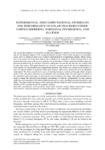Experimental and Computational Studies on the Performance of Solar Trackers Under Vortex Shedding, Torsional Divergence, and Flutter

Ver/
Use este enlace para citar
http://hdl.handle.net/2183/27164Coleccións
- CITEEC-ME - Artigos [28]
Metadatos
Mostrar o rexistro completo do ítemTítulo
Experimental and Computational Studies on the Performance of Solar Trackers Under Vortex Shedding, Torsional Divergence, and FlutterAutor(es)
Data
2020Cita bibliográfica
Quintela, J. (2020). Experimental and computational studies on the performance of solar trackers under vortex shedding, torsional divergence, and flutter. International Journal of Computational Methods and Experimental Measurements, 8(4), 387-404. DOI: 10.2495/CMEM-V8-N4-387-404
Resumo
[Abstract] The current development of renewable energies has originated a number of new structural typologies that are the physical support of the energy production systems. Photovoltaic energy is a very mature source and it is obtained using rows of panels implemented in a longitudinal grillage. Many studies have been carried out in the past with an aim to improve the capacity to obtain electrical power, but another important issue is the need to guarantee the performance of these industrial facilities under the phenomena induced by the turbulent wind flow, taking into account the fact that they are usually built in wide open spaces. This paper describes an extensive research carried out on two configurations of solar trackers by experimental and computational methods. The former was composed of a number of tests of reduced models of segments of the solar trackers, which were carried out in an aerodynamic wind tunnel. The latter consisted of a series of structural analyses worked out through a finite element model of the full panel subjected to aerodynamic and aeroelastic loads. Several angles of attack of the wind flow and a wide range of wind speeds were included in the study. This approach allowed to clearly evaluate the structural and dynamic performance of both the configurations of solar trackers under the most important wind-induced phenomena such as vortex shedding, torsional divergence, and flutter. The paper relates the phases of the study and informs about the more relevant numerical results obtained in the experiments and the computer analysis.
Palabras chave
Aerodynamic and aeroelastic loads
Finite elements models
Flutter
Photovoltaic energy
Solar trackers
Structural analysis
Torsional divergence
Vortex shedding
Wind tunnel test
Finite elements models
Flutter
Photovoltaic energy
Solar trackers
Structural analysis
Torsional divergence
Vortex shedding
Wind tunnel test
Versión do editor
Dereitos
Copyright: WIT Press





